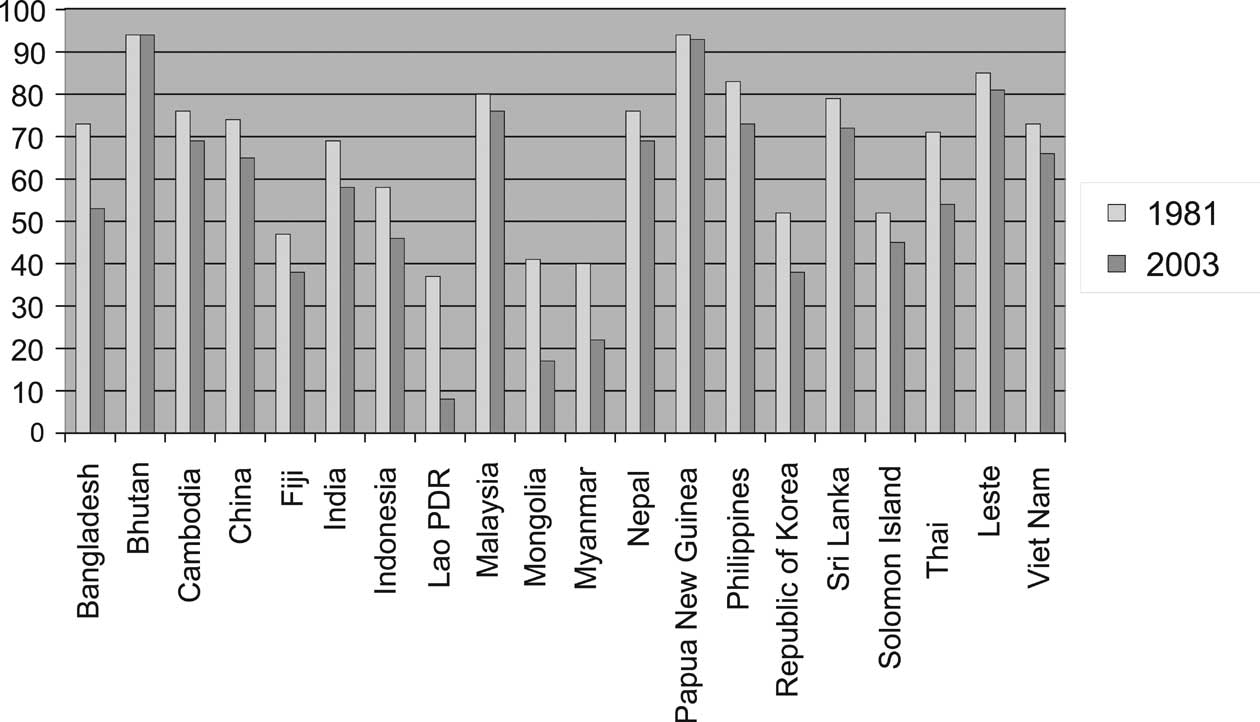in nonfarm activity. When agriculture stagnated, nonfarm employment offered a way out; these workers were pushed into this employment, not pulled by dynamic nonfarm activities (Islam, 1997).
The region's females participated in agriculture at 3 3.1 % for South Asia and 47.2% for East Asia and the Pacific (ILO, 2006). From 1995 to 2002 female labor continued to be important in the region's agriculture labor force. If women's contribution as family workers also was considered, then women were critical in the region's agriculture (UNDP, 2005). In recent decades the debate on agricultural labor in the region focused on "feminization of agriculture," the predominance of women in the sector. Evidence has shown that more women than men participate in agriculture. Indeed, women's participation in agriculture is substantial and increasing (UNDP, 2004).
Asia was the world's most densely populated region and also had the most child labor, approximately 61% of the total. About one in five children in Asia worked, 21 % (ILO, 1998). ESAP had the most child workers in the 5-to-14 age group, about 127 million. Not all these children were classified as child laborers, although they were below the minimum working age. Within ESAP child labor in agriculture was common among boys and girls, and most child laborers live in rural areas (ILO, 2005). Families in poverty consider child labor an asset to improve access to income and food, but a productive, literate and educated asset is lost.
Unpaid women and men contribute much to economic activity but are not credited appropriately in the United Nations System of National Accounts. The unpaid work within the System of National Accounts boundary included unpaid work in a family enterprise or agricultural holding (ESCAP and UNDP, 2003). Estimates of women in the labor force were not comparable internationally because in many countries large numbers of women assist on farms or in other family enterprises without pay and countries differed in the criteria to determine the extent such workers were counted as part of the labor force (World Bank, n.d.). In South Asia, |
|
female official employment rates usually were low because of arbitrary definitions. If definitions were revised and all activities for which women are traditionally responsible were incorporated, a huge difference in activity rate would be noted (Mahabub ul Hag Development Centre, 2003). Until and unless the unpaid work by men, women and children is measured as labor contribution to agriculture and rural economic production, the labor contribution of rural households will not be fully accounted.
Linguistic, ethnic and religious diversity is the hallmark of the region. About 70% of the world's more than 250 million indigenous peoples live in Asia and the Pacific. Margin-alization and poverty in many indigenous communities are closely linked to being deprived of the ability to lead lives they value (IFAD, 2002a). Ethnic diversity, while enriching the cultural heritage, in recent times has also caused ethnic conflict. Ethnic conflict adversely affects rural productivity and livelihood security (Wanasundera, 2006).
1.3.4 Education: Gender and rural disparities
South and West Asia had countries with a literacy rate of about 60%. Although the East Asia and Pacific region had 91% literacy, the highest rate among developing regions, its large population was home to 17% of illiterate adults worldwide. A considerable difference among regions in literacy gains was evident in UNESCO categories. In all regions, for both adults and youth, female literacy rates were lower than those of males. More remarkable was the poor literacy gain in South and West Asia, which included two of the most populous ESAP countries, India and Bangladesh (UNESCO, 2006). In South and West Asia, on average 93% of boys and 86% of girls of the relevant age were enrolled in primary education. This region had 38% of the world's out-of-school children, 56% girls.
In East Asia and the Pacific, on average 94% of boys and 94% of girls of the relevant age were enrolled in primary education. This region had 9% of the world's out-of-school children, 49% of whom were girls (UNESCO, |

